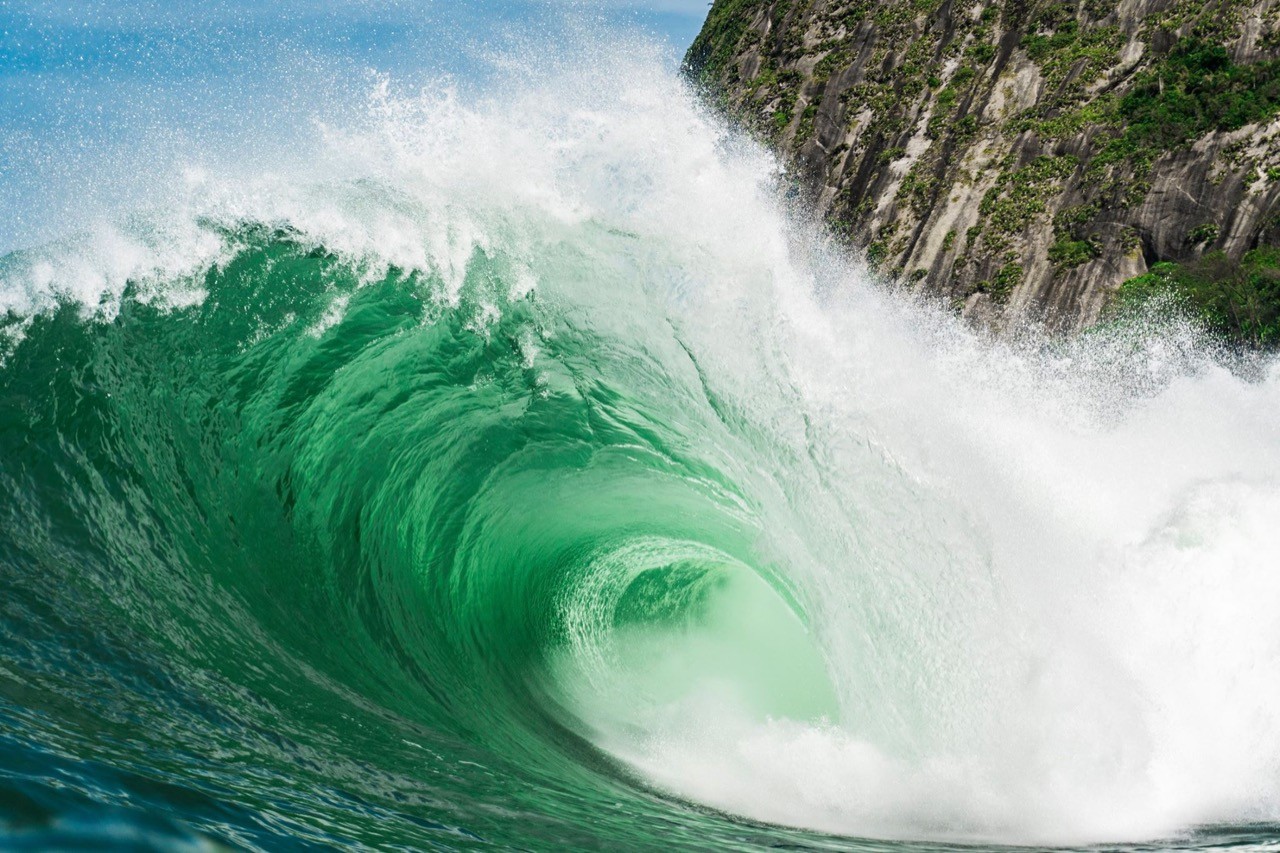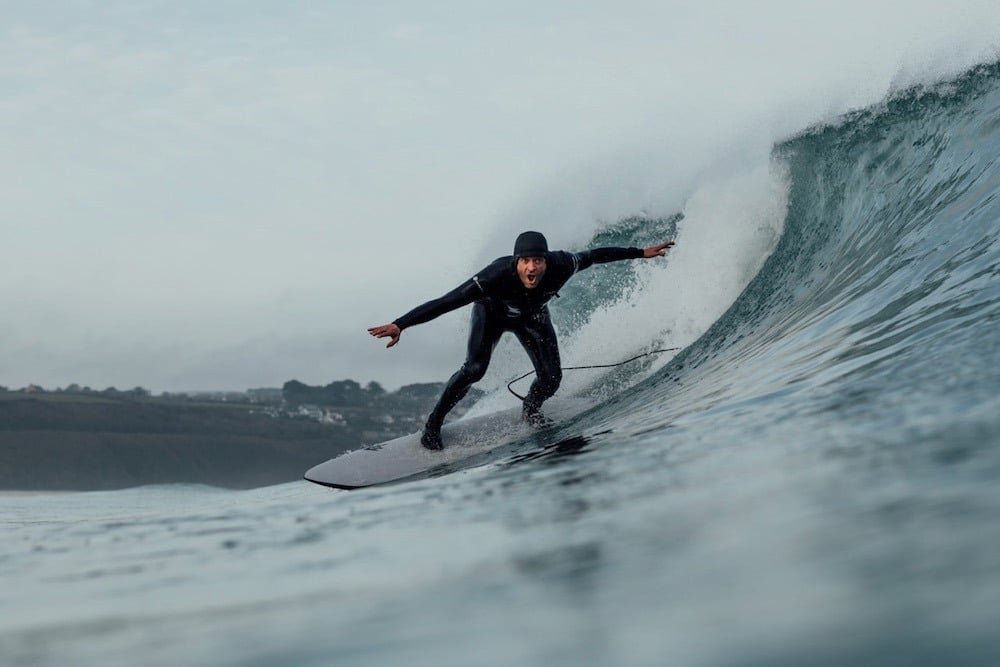Cold Water Surfing in the UK


Surfing the UK in Winter
Into the freezer: Cold water surfing – what’s the attraction? Alf Alderson looks at the dedication if not obsession required to paddle out into the waves when it’s snowing.
It’s Christmas Day in Pembrokeshire and depending on your age you’ll be ripping the wrapping paper off your presents or preparing for a brisk walk along the beach before settling down to Christmas dinner.
Unless you surf.
Because if you do, this is the time of year when you’ll be more excited about riding waves than opening Christmas presents. Forget the single-digit sea and air temperatures and biting winds, the period from late October to April is when the surf action really kicks off for Britain’s dedicated band of cold water surfers.
The surf is bigger, more consistent and less crowded than in the summer, so what’s not to like – apart from the cold?
On my own local beaches of Whitesands and Newgale, on Christmas morning – and every other winter morning – there will invariably be a group of surfers huddled together checking out the waves if there’s a swell.
In Pembrokeshire we’re lucky as the air and water temperatures are relatively mild year round – it never gets much below 7-8C; head across to the North Sea coastline and Yorkshire’s thriving surf scene, or to Scotland’s wave lashed north coast and stories of scraping snow and ice off car windscreens before driving to the beach are common.

Photo: Flickr Gareth Vaughan
Yorkshire-based surfer Seb Ramsay tells of surfing in South Shields one January. “The temperature was around freezing and it was sleeting as I put on my winter wetsuit, hooded rash vest, boots and gloves. As I walked down to the beach a local surfer was coming out of the water wearing a sleeveless wetsuit with a flowery cotton shirt underneath!
“No hood, no boots, no gloves. I asked him how long he’d been in. He said two hours. I managed 15 minutes and only because I couldn’t leave until he’d driven off…”
They’re clearly made of different stuff on Tyneside..
But just what is the attraction of paddling out into steel grey waves that guarantee an ‘ice cream headache’ when they crash over your head, when you can sometimes hardly unzip your wetsuit after a surf because your hands are so numb and where so many surf sessions start with a ritual that borders on masochism – squeezing into a cold, wet wetsuit?
Professional big wave surfer Gabe Davies is a good man to ask – he used to be based in South West France where he could surf relatively warm waves all year round, but recently moved back to his home lands near Newcastle with his wife and young son.
“I don’t mind the cold water. Once you’re in you just keep moving and the waves take your mind off the pain!”
Honestly though, wetsuits are so good now that if you invest in good equipment you can easily surf throughout the winter months.
“What is the killer for me though are those windy car parks – that horrible time just before or after a surf when you’re standing in a towel wrestling with a wetsuit and getting blitzed by the wind, hail, sleet, or snow which usually accompany the best British swells in the darkest months of winter”.
One of the major attractions of winter surf is the fact that the waves are so much bigger and more powerful. As North Devon surf photographer Ester Spears points out “There are loads more spots to surf – places that only work with bigger swells – and it’s more fun than summer because of the lack of crowds. It’s usually just you and a few friends”.

No better time than Winter in Woolacombe, North Devon
“Those powerful winter swells can lead to ‘surfaris’ along stretches of coastline you may never venture to in the warmer months of the year.”
For instance, in a big winter storm St. David’s Head in Pembrokeshire will often be submerged by the wash and spray from huge swells despite the fact that its 70 metres above sea level; surfing the adjacent beach, Whitesands, is clearly out of the question.
So local surfer will drive north to the sheltered bays and coves of Cardigan Bay which rarely get surf in summer, but in powerful winter swells can offer up fantastic point breaks.
Winter can also be a good time to learn if you don’t mind the cold as the waves are consistent and the crowds few and far between. Pembrokeshire single mum Anne-Marie Gallagher tells how she and her four daughters all caught the surfing bug in February 2006.
Video by Xander Ettling Media
“I threw myself into freezing February waters and dragged my daughters along for the experience too. Afterwards, I’d drive to the Druidstone Hotel above St. Brides Bay and sample one shot of a different whisky every Sunday as a reward to myself for cramming all five of us inside one changing room at Newgale and pulling wet wetsuits, boots and gloves off freezing but happy bodies”.
Where winter surfing was once a sport for the obsessive and hardy (or maybe foolhardy…) it’s now taken off to the extent that Cornish surfwear company Finisterre manufacture clothing and equipment designed specifically for cold water surfing.
And founder Tom Kay walks the walk, saying that “The north coast of Scotland is a real favourite of mine. Sure it’s pretty chilly, but there are plenty of waves waiting to be discovered, and checking out the hidden nooks and crannies of the coastline gives you a real feeling of exploration.”
Video by EndlessWinterMovie
And there’s always one consolation, however chilly it may be as you sit in icy seas waiting for a cold, steel blue wave to roll your way; it won’t be long until summer…
UK Surf Knowledge
Equipment
You’ll need a top quality hooded wetsuit to keep you warm in the depths of winter. Patagonia’s R4 hooded wetsuit (£425) is designed for water temperatures between 3 – 8C.
You’ll also need wetsuit boots and gloves at around £25 – 40 each at Down The Line Surf Shop.
Clothing
Finisterre offer an excellent range of clothing from underwear to outerwear designed specifically for cold water surfers. Check out their Mistral waterproof and breathable jacket (£185), and the Signum insulated and windproof shirt (£150).
Hardware
If you’re a committed winter surfer you’ll already know what type of board you prefer; by and large you’ll need a longer surfboard for more powerful winter waves. A good value option of you want one board for both winter and summer conditions is Guts Surfboards ‘Mule’ (£449)
Where to do it
Big swells hit the British coastline regularly from October through to April, and you can surf a lot of places that don’t generally get waves in summer, such as the south coast of England, East Anglia and Cardigan Bay.
Water temperatures will vary from lows of around 7C in SW England to 3-4C in northern Scotland. Note that the lowest water temperatures are not in the depths of winter but in late winter/early spring.
Once you start shivering it’s time to leave the water – your physical and mental capacities will diminish rapidly if you get too cold and you don’t want to be out in big winter surf when you’re not firing on all cylinders.
Last updated on May 7, 2018Have you subscribed to our Newsletter or Podcast? Listen to us on Apple Podcast and Spotify and follow us on Facebook, Instagram Twitter and YouTube.








